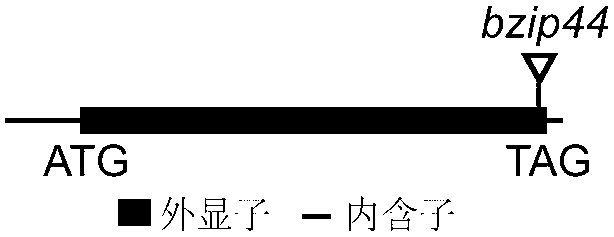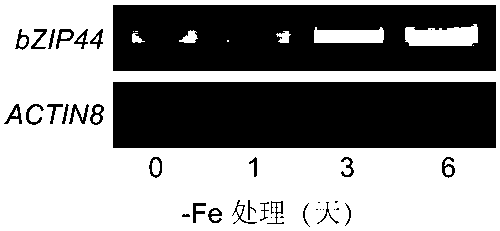Coding gene for enhancing iron deficiency tolerance and accumulation of plant and application of coding gene
A technology that encodes genes and plants, applied in the field of bioengineering, can solve problems such as time-consuming and labor-intensive efficacy, inconspicuousness, and lack of iron nutrition
- Summary
- Abstract
- Description
- Claims
- Application Information
AI Technical Summary
Problems solved by technology
Method used
Image
Examples
Embodiment 1
[0026] Embodiment 1, ZIP44 Identification of Transgenic Plant Transcript Level and Its Response to Iron Deficiency
[0027] Compared with the use of MS medium without iron to screen the Arabidopsis seed mutant library, a mutant strain sensitive to iron deficiency was obtained, and the mutant was found to be ZIP44 loss-of-function mutants, named bzip44 . Because the seed is a T-DNA insertion mutation, it is amplified by PCR with specific primers and sequenced. The sequencing results are compared in the NCBI database Blast, and the T-DNA insertion site information is obtained through comprehensive analysis. See figure 1 . Using qRT-PCR, the bzip44 The mutants were identified at the transcript level, and it was found that in the two mutants ZIP44 The expression levels of the genes were significantly lower than those of the wild type, see figure 2 . see image 3 In order to further determine ZIP44 Whether the gene responds to iron deficiency stress in plants, we e...
Embodiment 2
[0029] Embodiment 2, cultivating iron-deficiency-tolerant Arabidopsis
[0030] 1, ZIP44 Gene Overexpression Transgenic Lines bZIP44-OE1, OE2 the acquisition
[0031] To further verify the function of this gene in the regulation of iron deficiency stress in plants, we constructed ZIP44 Gene overexpression vector ( 35S: bZIP44 ). Firstly, the target fragment is amplified. The wild-type Arabidopsis was normally cultured on MS medium for two weeks, the total RNA of the plant was extracted, reverse-transcribed to synthesize cDNA, and the synthesized cDNA was used as a template for PCR to amplify a sufficient amount of the target product. Using the PCR product as a template, the second amplification was carried out for the purpose of introducing enzyme cutting sites. The PCR product and vector pCAMBIA1301 were digested and recovered. Then, the recovered and purified target DNA fragment and the vector were ligated overnight with T4 DNA ligase. The above ligation solution ...
PUM
 Login to View More
Login to View More Abstract
Description
Claims
Application Information
 Login to View More
Login to View More - R&D
- Intellectual Property
- Life Sciences
- Materials
- Tech Scout
- Unparalleled Data Quality
- Higher Quality Content
- 60% Fewer Hallucinations
Browse by: Latest US Patents, China's latest patents, Technical Efficacy Thesaurus, Application Domain, Technology Topic, Popular Technical Reports.
© 2025 PatSnap. All rights reserved.Legal|Privacy policy|Modern Slavery Act Transparency Statement|Sitemap|About US| Contact US: help@patsnap.com



